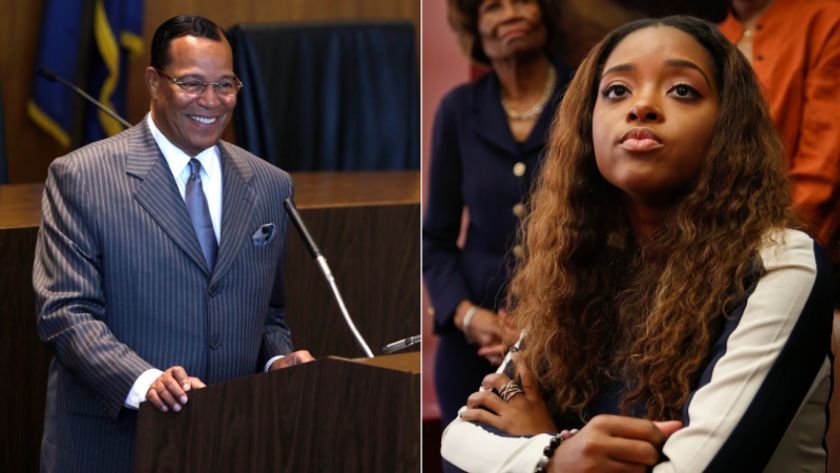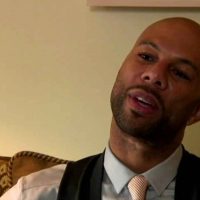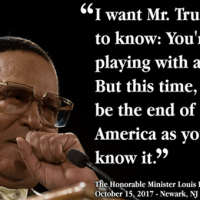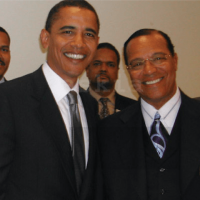A movement of bigotries can only divide us.
A funny thing happened on the way to the intersectional future. The proverbial knapsack was unpacked in the Women’s March and inside wasn’t just racial tribalism, but racial and religious supremacism.
Why do Tamika Mallory and Linda Sarsour of the Women’s March like Farrakhan and his hate group?
The Nation of Islam preaches that black people are the master race. It doesn’t just hate white people, Jews and a whole bunch of other folks. It hates them out of a conviction in its own superiority. According to its teachings, “the Blackman is the original man” and lighter skinned people were “devils” created by an evil mad scientist to rule over black people until they are destroyed by UFOs.
It even teaches that monkeys are descended from white people.
Progressive media essays defending Obama, Rep. Keith Ellison, Rep. Danny Davis, Mallory and other black leaders for their Farrakhan links have urged concerned liberals to look at the positive aspects of the Nation of Islam, its love for black people, not the negative, its hatred for white people.
But it is the “positive” that is the problem.
Intersectionality promises to package tribal identity politics into a utopia of social justice. But the essence of tribalism is the superiority of your people and the inferiority of all other groups. Tribalism doesn’t have to be violent, hostile or hateful. Most peoples are tribal after all. But when you combine the most radical identity politics elements, as the left does, then bigoted supremacism is certain.
The clown car of identity politics runs smoothest when it has a common enemy: white people. Coalitions like the Women’s March assemble an array of groups who are united by their hatred of Trump, white people, Israel and root beer. And it works as long as no one lifts up the hood and looks at the engine.
Black nationalism is racist, sexist, anti-Semitic and homophobic. The Nation of Islam isn’t an exception. From Jeremiah Wright, “Italians… looked down their garlic noses”, to Eldridge Cleaver, “rape was an insurrectionary act” to Amiri Baraka, the ugliest possible supremacist bigotry is its natural state.
“We are all beautiful (except white people, they are full of, and made of s___),” Amiri Baraka wrote. “The fag’s death they gave us on a cross… they give us to worship a dead jew and not ourselves.”
“I got the extermination blues, jew-boys. I got the Hitler syndrome figured… So come for the rent, jewboys,” the Guggenheim fellowship, PEN and American Book Award winner, and former Poet Laureate of New Jersey ranted.
Baraka was one of the country’s most celebrated black nationalist poets and he was a former member of the Nation of Islam. Baraka’s Black Mass circulated the NOI’s racist creation myth.
It was the NOI’s conviction of black superiority and white inferiority that attracted Baraka and so many other black nationalists. The NOI is one of a variety of black supremacist religious groups, from the similarly exotic Moorish and Black Hebrew churches, to NOI splinter groups such as Five-Percent Nation and black nationalist churches like the one attended by the Obamas and presided over by Jeremiah Wright. But religious black supremacism is only a component of a larger cultural movement that lies at the heart of black nationalism and mingles historical conspiracy theories with racial supremacism.
The comingling of black nationalism with intersectional politics has produced a new generation (often of second-generation radicals) that dresses up its racism not only in the lyricism of the old black nationalism of Wright and Baraka, but in the obtuse academic jargon of intersectionality.
That’s where Tamika Mallory and Ta-Nehisi Coates come from. But political word salads and poetry only conceal what you choose not to pay attention to. And that’s why we’re talking about Louis Farrakhan.
The mass of progressive media articles, essays and explainers deployed to protect the Women’s March can be summed up as, “Stop paying attention.” And what we’re not supposed to be paying attention to is the slow death of liberalism and its substitution by the intolerant tribal extremism of identity politics.
It’s why the echo chamber of progressive media has turned against the New York Times editorial page where too many articles questioning identity politics and political censorship have appeared. Bari Weiss and Quinn Norton, articulate young women, are the most immediate targets, but the larger target is James Bennet, the page’s gatekeeper, who is unwisely giving liberals a glimpse of where they’re headed.
Link: https://www.frontpagemag.com/fpm/269596/intersectionality-tribalism-and-farrakhan-daniel-greenfield
Want more BFT? Leave us a voicemail on our page or follow us on Twitter @BFT_Podcast and Facebook @BluntForceTruthPodcast. We want to hear from you! There’s no better place to get the #BluntForceTruth.







